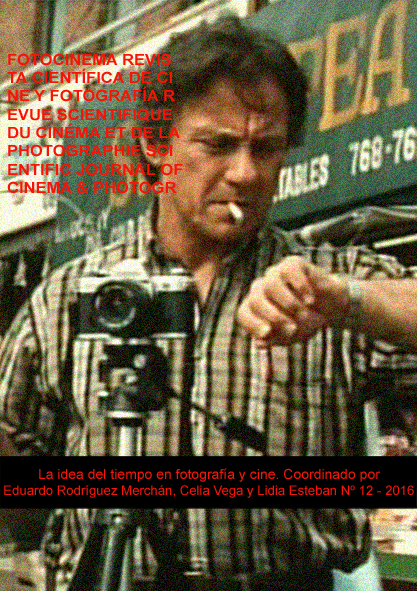Tiempo del eterno amor. Un marido de ida y vuelta de Luis Lucia
DOI:
https://doi.org/10.24310/Fotocinema.2016.v0i12.6044Abstract
La película Un marido de ida y vuelta de Luis Lucia (1957) es una adaptación de la comedia homónima de Enrique Jardiel Poncela (1939). En ella se pone de relieve una nueva concepción del tiempo con sus propias variantes y además con la noción de lo cómico. Ella se inspira parcialmente en el texto teatral de Poncela para tejer una fábula elaborada mediante la sucesión de unos cuadros temporales que enlazan los temas cruciales en Un marido de ida y vuelta. Está dividida en tres fragmentos-relatos que narra José, el protagonista principal del filme, las historias de la vida conyugal y supuestamente personales después de la muerte, materializándose en cuerpo, paseando por la casa y por las calles de Madrid.
Abstract:
Luis Lucia’s 1957 movie entitled Un marido de ida y vuelta is a film adaptation of Enrique Jardiel Poncela’s comedy written in 1939. It focuses on the concept of time, its variants and the new dimension of humourism. It is inspired partially with Poncela’s play and it consists of temporal frames which are connected by the main theme. The grotesque plot is divided into three parts, fragment-stories, and the main narrator is the protagonist, Jose, who dies suddenly from a heart attack during a carnival party. After a year, he comes back home as a “materialised” spirit, in order to regain his wife’s love and release her from her new husband’s and his old friend’s clutches.
Palabras clave:
Filme; variantes del tiempo; amor eterno; fantología.
Keywords:
Cinema; Time Variants; Eternal love; HauntologyDownloads
Metrics
Publication Facts
Reviewer profiles N/A
Author statements
Indexed in
-
—
- Academic society
- N/A
- Publisher
- Universidad de Málaga
Downloads
Published
How to Cite
Issue
Section
License
All contents published in Fotocinema Revista científica de cine y fotografía are protected under the Creative Commons Attribution-NonCommercial-ShareAlike 4.0 International (CC BY-NC-SA 4.0) license. All about this license is available in the following link: <http://creativecommons.org/licenses/by-nc-sa/4.0>
Users can copy, use, redistribute, share and exhibit publicly as long as:
- The original source and authorship of the material are cited (Journal, Publisher and URL of the work).
- It is not used for comercial purposes.
- The existence of the license and its especifications are mentioned.
There are two sets of authors’ rights: moral and property rights. Moral rights are perpetual prerogatives, unrenounceable, not-transferable, unalienable, imprescriptible and inembargable. According to authors’ rights legislation, Fotocinema. Revista científica de cine y fotografía recognizes and respects authors moral rights, as well as the ownership of property rights, which will be transferred to University of Malaga in open access. The property rights are referred to the benefits that are gained by the use or the dissemination of works. Fotocinema. Revista científica de cine y fotografía is published in an open access form and it is exclusively licenced by any means for doing or authorising distribution, dissemination, reproduction, , adaptation, translation or arrangement of works.
Authors are responsable for obtaining the necessary permission to use copyrighted images.














13.png)



